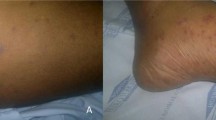Abstract
The frequency of breakthrough invasive fungal diseases (IFDs) during echinocandin therapy is unclear. We retrospectively analyzed 534 hematologic patients treated with echinocandin (caspofungin, N = 55; micafungin, N = 306; anidulafungin, N = 173). Four proven IFDs were found, caused by Candida parapsilosis (N = 2), C. parapsilosis and Candida glabrata (N = 1), and Fusarium species (N = 1). Four cases of possible IFDs were observed, all showing pulmonary infection. One case showed features suggestive of hepatosplenic candidiasis. Six of these eight cases had previously received the purine analog clofarabine. Breakthrough IFD during echinocandin treatment occurred infrequently (1.5 %), caused predominantly by Candida species. Clofarabine usage was an important risk factor.

Similar content being viewed by others
References
Chen SC, Slavin MA, Sorrell TC (2011) Echinocandin antifungal drugs in fungal infections: a comparison. Drugs 71:11–41
Sun HY, Singh N (2010) Characterisation of breakthrough invasive mycoses in echinocandin recipients: an evidence-based review. Int J Antimicrob Agents 35:211–8
De Pauw B, Walsh TJ, Donnelly JP et al (2008) European Organization for Research and Treatment of Cancer/Invasive Fungal Infections Cooperative Group; National Institute of Allergy and Infectious Diseases Mycoses Study Group (EORTC/MSG) Consensus Group. Revised definitions of invasive fungal disease from the European Organization for Research and Treatment of Cancer/Invasive Fungal Infections Cooperative Group and the National Institute of Allergy and Infectious Diseases Mycoses Study Group (EORTC/MSG) Consensus Group. Clin Infect Dis 46:1813–21
Freifeld AG, Bow EJ, Sepkowitz KA, Boeckh MJ et al (2011) Infectious Diseases Society of America. Clinical practice guideline for the use of antimicrobial agents in neutropenic patients with cancer: 2010 update by the infectious diseases society of america. Clin Infect Dis 52:e56–93
Tse E, Leung AY, Sim J et al (2011) Clofarabine and high-dose cytosine arabinoside in the treatment of refractory or relapsed acute myeloid leukaemia. Ann Hematol 90:1277–81
Ortega M, Marco F, Soriano A et al (2011) Candida species bloodstream infection: epidemiology and outcome in a single institution from 1991 to 2008. J Hosp Infect 77:157–61
Pfaller M, Boyken L, Hollis R et al (2011) Use of epidemiological cutoff values to examine 9-year trends in susceptibility of Candida species to anidulafungin, caspofungin, and micafungin. J Clin Microbiol 49:624–9
Pfaller MA (2012) Antifungal drug resistance: mechanisms, epidemiology, and consequences for treatment. Am J Med 125(1 Suppl):S3–13
Garcia-Effron G, Katiyar SK, Park S, Edlind TD, Perlin DS (2008) A naturally occurring proline-to-alanine amino acid change in Fks1p in Candida parapsilosis, Candida orthopsilosis, and Candida metapsilosis accounts for reduced echinocandin susceptibility. Antimicrob Agents Chemother 52:2305–12
Pang KA, Godet C, Fekkar A et al (2012) Breakthrough invasive mould infections in patients treated with caspofungin. J Infect 64:424–9
Chan TS, Hwang YY, Gill H et al (2013) Antifungal drug usage in haematologic patients during a 4-year period in an Asian university teaching hospital. Intern Med J 43(5):541–6
Conflict of interest
The authors have no conflict of interest to declare.
Author information
Authors and Affiliations
Corresponding author
Rights and permissions
About this article
Cite this article
Chan, T.S.Y., Gill, H., Hwang, YY. et al. Breakthrough invasive fungal diseases during echinocandin treatment in high-risk hospitalized hematologic patients. Ann Hematol 93, 493–498 (2014). https://doi.org/10.1007/s00277-013-1882-2
Received:
Accepted:
Published:
Issue Date:
DOI: https://doi.org/10.1007/s00277-013-1882-2




